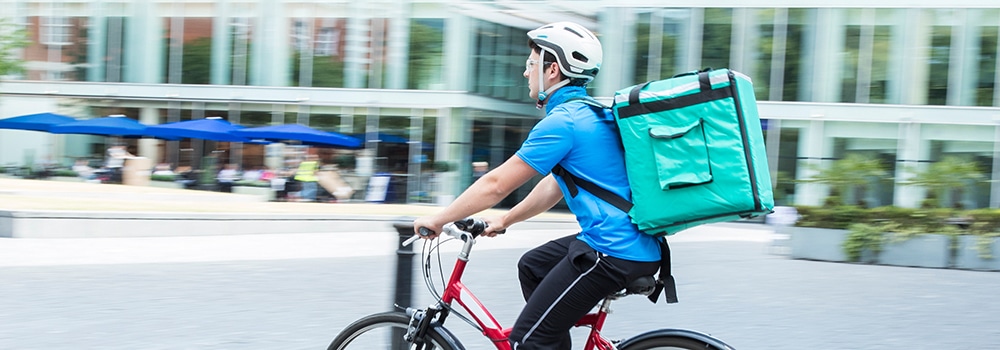Menu
Login
- SOLUTIONS
-
-
FRANCHISEES
-
FRANCHISORS
PARTNER VENDORS
-
-
-
- MARKETPLACE
- RESOURCES
- ABOUT
- SCHEDULE A DEMO
-

Delivery has traditionally been reserved for pizza, Chinese food, and more recently, sandwiches. Takeout has long been an option with most restaurants, but with the explosion of "gig economy" delivery services like BiteSquad, Door Dash, and UberEats, more and more consumers are opting to "dine-out" in the comfort of their own home. As a result, QSRs are faced with choosing to partner with the third-party delivery organizations like GrubHub, provide their own delivery service, or develop a curbside-to-go program.
No matter which option works best for your business, here's how to conquer off-premises dining.
When you think about it, it's a surprise that the gig economy didn't come to the restaurant industry sooner. If Uber and Lyft let you pay any average Joe to drive you from place to place, why not pay that average Joe to pick up your dinner and bring it to you? That's what third-party services like BiteSquad do, and why they've been so successful. Gone are the days of choosing between pizza and Chinese food for delivery. In the mood for sushi? A chicken sandwich? A slice of cake? For the right price, someone will bring it to your door.
If your QSR doesn't deliver, partnering with one of these services is probably a no-brainer. With minimal effort, you gain access to customers who are unwilling or unable to dine in at your store. But there are some risks with this option that you need to consider.
Delivery services charge restaurants for the privilege of using their platform, and that cost isn't trivial — depending on the service, your QSR, and your region, the fee can be anywhere from 15%–30%. Depending on your margins, you'll have to consider whether the added convenience is worth that much of a loss.
It's also more difficult to manage expectations with a third-party service. You can train your employees on best food handling practices and hold them accountable if orders are late or food is cold. With third-party services, once the food leaves your store, it's out of your hands — for better or worse. And while some services take accountability for late or improperly handled orders, it's hard to make up for the cost of a dissatisfied customer.
Third-party delivery services have made delivery a viable option for almost every restaurant and QSR. However, according to the 2016 edition of Technomic's annual Takeout & Off-Premise Consumer Trend Report, 42% of consumers aged 18-35 would prefer to order directly from a restaurant instead of a third-party service. That number rises to 46% for diners over the age of 35. If you're able to consider the option, an in-house delivery service may be more effective than a partnership with an external service.
Hiring your own delivery drivers gives you the advantage of complete control over the entire process, from the moment an order is placed to the time it reaches your customer's door. You can better manage expectations about delivery time and forecast your staffing to make sure you always have the right amount of drivers on hand. And you don't have to pay hefty services fees, either.
For many QSRs, delivery is simply an impractical solution. But you can still look at curbside-to-go as an option over traditional carryout. With curbside-to-go, your employees bring customers carryout orders directly to their cars. You might be thinking, "If customers are already driving to the QSR, can't they just get their own orders?" Well, yes, they can. Carryout has been a viable option for years in many restaurants, especially for pizza and for QSRs like Panera Bread (Panera, notably, has added delivery to many of its stores in recent years). But, if you're able to support it, curbside-to-go is an enticing option for existing customers and can even help attract new ones.
With curbside-to-go programs, customers place their orders in advance. Then, when they arrive at the store, an employee brings the order to their car. Customers that need time to carefully select their options have the ability to do so without the pressure of a drive-thru. Customers with mobility issues don't have to try to move their food from the store to their car. Plus, it makes customers feel special — like valet parking, but with dinner.
With any of these options, you may have to make some logistical changes to your QSR. If you anticipate delivery or curbside takeout being successful enough to reduce the number of dine-in customers, you may want to reclaim some of your dining area and increase your food prep space. You may want to do this anyway, in order to give your employees more space to prepare delivery and takeout orders without slowing down customers who order in-store.
Think carefully about whether any of these off-premises dining options works for you. More ways to order helps you retain customers in an ever-changing world.
Delaget is the number one resource for QSR data aggregation and understanding. Smarter Wins.
PAR OPS' blog on operational strategies to grow your business faster.
Everything You Need to Know About Hiring & Retaining Teenagers During the 2021 Labor Crisis
Nickels and Dimes: 4 QSR Operational Money-Savers You Likely Haven’t Tried Yet
QSR Loss Prevention: 4 Ways to Prevent and React to Employee Theft